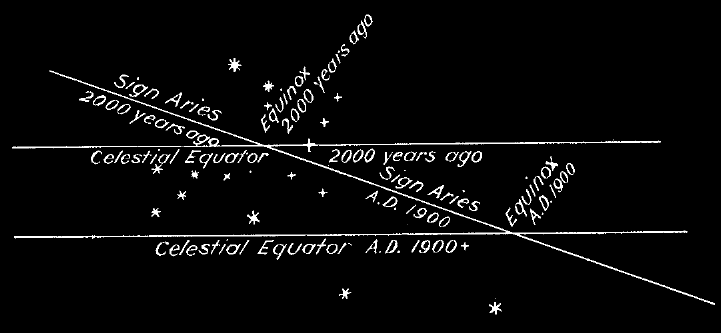 |
The nature of precession is now to be explained. The equinox is the point where the sun crosses the celestial equator. The position of the celestial equator on the celestial sphere is determined by the direction of the earth’s axis, because the celestial equator is 90° from either celestial pole.
The precession of the equinoxes arises from the fact that the direction of the earth’s axis in space is slowly changing.
Next, let us see how the change goes on. Imagine a line passing through the sun perpendicular to the plane of the ecliptic. The point in which this line, when continued to the stars, meets the celestial sphere, is called the Pole of the Ecliptic. It lies in the constellation Draco, the Dragon, but there is no bright star near it.
You will readily see that the angular distance between the pole of the ecliptic and the celestial pole, corresponding to the direction of the earth’s axis, is equal to the obliquity of the ecliptic, 23½°.
Now, the law of precession is that the celestial pole is in motion, and makes a complete revolution round the pole of the ecliptic in about 25,700 years. This motion is very slow to ordinary vision; it would take a century for the naked eye to notice it, even by careful observation. But the exact observations made by astronomers with the meridian circle make it evident month after month and year after year.
 |
Owing to this motion of the celestial pole the celestial equator moves also, continually sliding along the ecliptic, and carrying the equinoxes with it, as shown in figure 23. This is why the equinox moves among the stars. The rate of motion is a little more than 50" in a year, or nearly 14° in 1000 years.
Motion of the Ecliptic. -- If the plane of the ecliptic were absolutely fixed, the obliquity of the ecliptic would be always the same, and the motion of precession would go on forever at the same rate that it now does. But the attraction of the other planets on the earth produces a very slow change in the ecliptic itself, about 1/50 the change of precession. In consequence of this change, the revolution of the celestial pole round the pole of the ecliptic does not take place at an exactly uniform rate, nor will it always be completed in exactly the same time. For the same reason the obliquity of the ecliptic slowly changes. It is at the present time diminishing at the rate of about 46" in a century.
Results of Precession. -- One result of precession is that the celestial pole was not so near the polestar in former times as it is now. In ancient times it was so far away from that star that the latter could not be considered as a polestar at all. It has been continually coming nearer, and is still approaching it. About the year 2110 it will pass by the polestar at a distance of only 24'. Continuing its course, the celestial pole will pass some 5° from the star Alpha Lyre, about 11,000 years from now, and will continue its circuit until it gets back to where it now is in about 25,700 years.
The two equinoxes will make a revolution round the equator in the same period of time, being carried along by the earth's equator, which is always at right angles to the earth's axis.